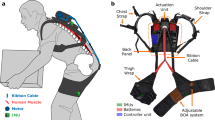Abstract
Vertical movement of the hip during locomotion causes a loaded backpack to be accelerated with each step1, which imposes large peak forces on the wearer. Here we show that using bungee cords to suspend the load from a backpack frame reduces not only its vertical movement, and hence its vertical force on the carrier, but also the energetic cost of walking with the pack. This permits larger loads to be carried while moving rapidly, and at the same time reduces the risk of orthopaedic and muscular injury.


Similar content being viewed by others
References
Kram, R. J. Appl. Physiol. 71, 1119–1122 (1991).
Gard, S. A., Miff, S. C. & Kuo, A. D. Hum. Mov. Sci. 22, 597–610 (2004).
Rome, L. C., Flynn, L., Goldman, E. M. & Yoo, T. D. Science 309, 1725–1728 (2005).
Grabowski, A., Farley, C. T. & Kram, R. J. Appl. Physiol. 98, 579–583 (2005).
Donelan, J. M., Kram, R. & Kuo, A. D. J. Exp. Biol. 205, 3717–3727 (2002).
Balogun, J. A. et al. Ergonomics 29, 1623–1635 (1986).
Chatterjee, A., Pratap, R., Reddy, C. K. & Ruina, A. Int. J. Robot. Res. 21, 621–34 (2002).
Troussier, B., Davoine, P., de Gaudemaris, R., Fauconnier, J. & Phelip, X. Scand. J. Rehabil. Med. 26, 143–146 (1994).
Negrini, S. & Carabalona, R. Spine 27, 187–195 (2002).
Taimela, S., Kujala, U. M., Salminen, J. J. & Viljanen, T. Spine 22, 1132–1136 (1997).
Author information
Authors and Affiliations
Corresponding author
Ethics declarations
Competing interests
L Rome formed an entity (Lightning Packs LLC) in 2004 to hold intellectual property (one patent issued 2006 and others pending), and eventually develop the electricity-generating backpack. L Rome and his family own all the equity in this entity. This entity remained dormant until 3 months ago (after the completion of the work in this manuscript), when it received modest small business grants from the US government to pursue commercialization of the electricity-generating backpack. The other authors, Louis Flynn and Taeseung Yoo are not involved in the entity, nor do they have any financial interest in the entity.
Supplementary information
Supplementary Information
Contains supplementary methods, supplementary tables and reference lists.
Video 1
Running with locked backpack
Video 2
Running with suspended backpack
Video 3
Suspended and locked backpack Side by Side
Rights and permissions
About this article
Cite this article
Rome, L., Flynn, L. & Yoo, T. Rubber bands reduce the cost of carrying loads. Nature 444, 1023–1024 (2006). https://doi.org/10.1038/4441023a
Received:
Accepted:
Published:
Issue Date:
DOI: https://doi.org/10.1038/4441023a
- Springer Nature Limited
This article is cited by
-
Backpack with a nonlinear suspension system designed for low walking speeds
Archive of Applied Mechanics (2023)
-
A review of the design of load-carrying exoskeletons
Science China Technological Sciences (2022)
-
Backpack energy harvester managed by a modified fly-back converter
Microsystem Technologies (2021)
-
Passive-elastic knee-ankle exoskeleton reduces the metabolic cost of walking
Journal of NeuroEngineering and Rehabilitation (2020)
-
The Use of Wearable Assistive Technology to Increase Soldiers’ Effectiveness
Human Factors and Mechanical Engineering for Defense and Safety (2020)





